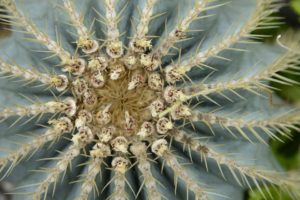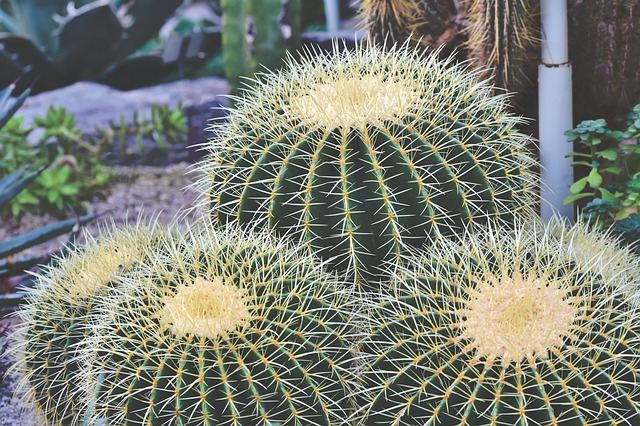Cactus have thorns, also known as spines or needles, for a number of environmental and evolutionary reasons. Cactus thorns play the same role in plant biology that leaves play in species that live in climates with better access to water. Without the thorns, cacti would be unable to survive in harsh desert conditions. Cacti don’t have traditional leaves, but thorns serve them better.
Water Conservation
 Thorns help cacti conserve water, focusing the suns rays directly onto the thorns for photosynthesis while shading the rest of the plant from harsh rays. If you look at a single thorn it doesn’t look like it would do much, but thorns grow in clusters that cover most of the surface of the cactus. Many thorns grow at different heights to provide different levels of coverage. Without thorns, cacti would cook in the sun, losing all their water within a few hours rather than thriving and being able to produce fruit.
Thorns help cacti conserve water, focusing the suns rays directly onto the thorns for photosynthesis while shading the rest of the plant from harsh rays. If you look at a single thorn it doesn’t look like it would do much, but thorns grow in clusters that cover most of the surface of the cactus. Many thorns grow at different heights to provide different levels of coverage. Without thorns, cacti would cook in the sun, losing all their water within a few hours rather than thriving and being able to produce fruit.
Some cacti in the genus Mammillaria will grow a white fuzz around the spines as they are getting close to flowering, conserving more water within the trunk of the cactus so the plant can easier survive flowering and bearing fruit. This fuzz is similar to cotton fibers and will not develop into thorns, but will instead slough off after the plant has flowered, returning it back to normal levels of homeostasis.
Protection From Erosion
We’ve already mentioned that cacti live in deserts, areas where large amounts of sand move around on a regular basis. Spines and their woody construction keep the inner stalk of the cactus from being eroded by the millions of sharp glass particles and shell fragments that make up sand. While the spines get worn down over them, the plant is able to regrow them at a much lower cost than leaves, allowing these rugged plants to thrive in areas where very little lives.
Keeping Predators Away

Humans know that cacti have water in them and survival shows and training often emphasize that you can drink the water contained within several species. There are many cultures that cook with cactus as well, so it shouldn’t be surprising that cactus have predators in the wild. Many mammals find them to be a delicious treat, but most won’t bother with them due to the thorns.
Species in areas with low survival rates tend to evolve larger thorns, attempting to keep away creatures that would damage or kill the plant with their appetites. Not many creatures are willing to take a bite out of something that causes them pain, a similar defense mechanism is found in plants like chili peppers and durian fruit. Plants that need animals to spread their seeds are often easier to eat, making them more appealing.
Better Durability
While the spines act like leaves, they are actually made of wood fibers and are much stronger than leaves. Deserts are prone to wind storms, deluges of water during the rainy season, and are home to many clumsy animals. Normal leaves would be destroyed very quickly under these conditions, while thorns are able to thrive and protect the cactus they grow on. Spines are also easier to replace when broken, not requiring the same delicate processes as leaves and tend to break off cleanly, not causing as much damage to the stalk of the plant.
Creating Homes For Bugs and Birds

Like all other plants in the world, cacti need to be pollinated and for that, they need to attract insects. The spines often provide a perfect home for different insect and spider species, protecting the cactus from more harmful species while ensuring ongoing pollination. Some cacti even host entire colonies of insects that further shade them from the sun and help keep their temperature down.
Some species of birds make their homes inside of cacti, such as the barrel or saguaro species. Hollowing out portions of the trunk allows them a shaded area in which to spend their days, while the thorns protect them from snakes and larger predators. The birds in turn eat harmful insects off of the plant. This symbiotic relationship has commonly been immortalized in indigenous art across the world. The cactus plays an important part in desert ecosystems, protecting biodiversity and providing shelter from the sun.
Whether you call them spines, thorns, spikes, or anything else. These amazing growths are the secret to the continued survival of the plant itself and much of the desert. The next time you see a cactus, take a closer look, you might be surprised at how complicated they really are.












